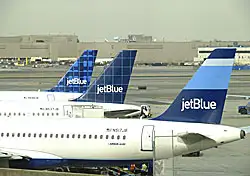
Those low-cost carriers (LCCs) are up to no good once again: They’ve gone and snagged a full 30 percent of the domestic market, writes Dan Reed at USA Today. And with larger airlines shedding routes and cutting back service, one has to wonder if there is any stopping these pesky little airlines.
Of course, “pesky” is only a truism if you’re a legacy line getting spanked by an LCC. And “little” isn’t really true at all, as carriers like Southwest (the nation’s largest airline in terms of passengers carried), JetBlue, Virgin America, and AirTran continue growing their route networks.
No, the only truth is that LCCs really are taking over. “Low-cost airlines – including big ones like Southwest, AirTran and JetBlue, and small ones like Frontier, Spirit, Virgin America and Allegiant – have grown rapidly in the past 10 years at the expense of United and other traditional mainline carriers such as Delta, American, Continental and US Airways,” Reed writes. “The conventional carriers, in turn, have cut flights in most markets, shrunk or closed hubs, and farmed a lot of routes out to regional affiliates. They’ve even abandoned service to some cities.”
So how have the LCCs done this? The obvious answer is that they’ve offered lower prices. But while that’s certainly part of it, a more accurate answer is that LCCs simply have the right product for the times, and perhaps a better product overall.
For starters, LCCs can generally offer better itineraries, thanks to point-to-point networks that cut down on connections, in contrast to the hub-and-spoke networks commonly found at legacies. Legacy lines tend to funnel travelers through major hubs like Atlanta or Chicago, meaning more connections. The LCC model leads to shorter flights and more convenient schedules.
More importantly, perhaps, is that Americans seem less inclined (or, more recently, less able) to spend money on travel like they used to. This, along with a degradation of service at the legacies (no meals, excessive fees, etc.) has led us to change what we consider a “good value” when it comes to air service. And for most travelers these days, the value offered by JetBlue (snacks, TV, decent seats) or Southwest (few fees, decent service) far exceeds whatever Delta, United, or US Airways can offer. Sure, Delta may match Southwest’s price, but many travelers (including those who read SmarterTravel) would contend Delta can’t come close to matching the latter’s value.
The final piece of the puzzle, of course, is the economy. Last year’s fuel crisis and the ongoing recession has hurt the industry across the board, but it hit the legacies hardest. Here, the LCCs were lucky—sure, they’ve run more efficient operations than larger carriers, but they’re also smaller, both in terms of employees and service. This makes them more adaptable, and even allowed them to grow while larger airlines cast off countless unprofitable routes and laid off thousands. Like I said, right product at the right time.
The question now is whether or not the low-cost model is the right model for the future. What do you think?
We hand-pick everything we recommend and select items through testing and reviews. Some products are sent to us free of charge with no incentive to offer a favorable review. We offer our unbiased opinions and do not accept compensation to review products. All items are in stock and prices are accurate at the time of publication. If you buy something through our links, we may earn a commission.
Related
Top Fares From
Today's Top Travel Deals
Brought to you by ShermansTravel
France: 8-Night Paris, Avignon & Nice...
Infinity Worldwide Vacations
 vacation
$2880+
vacation
$2880+
Poconos: 3 Nts in Garden of...
ResortsAndLodges.com
 hotel
$305+
hotel
$305+
7-Nt Canada & New England Cruise,...
Princess Cruises
 cruise
$839+
cruise
$839+



